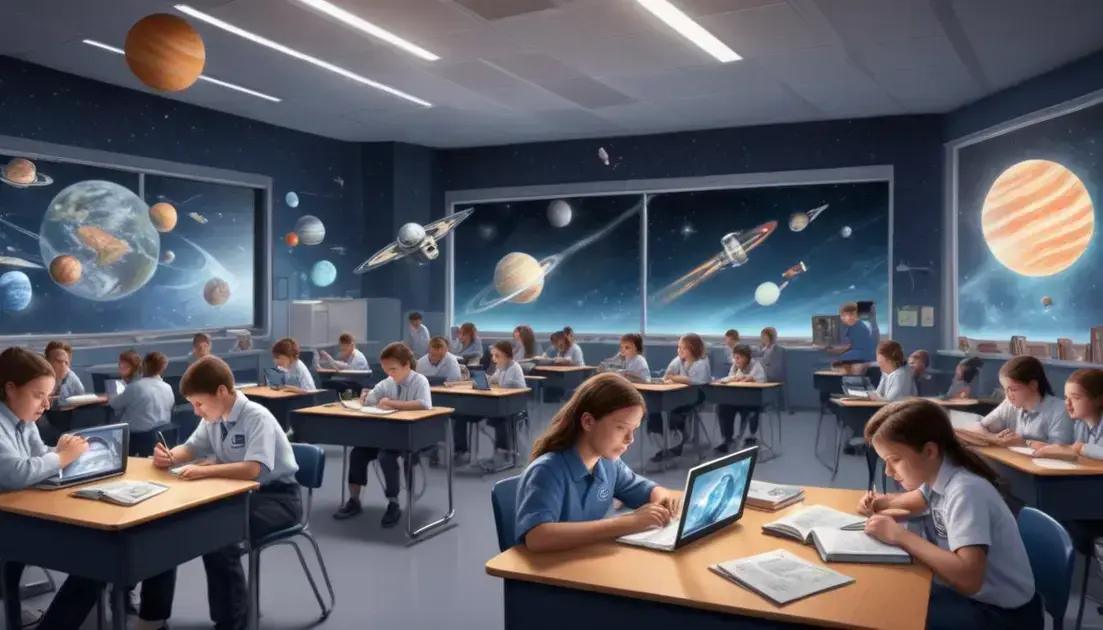
How the space race transformed education
The Space Race led to significant advancements in education and technology, fostering a strong focus on STEM (science, technology, engineering, and math). This movement inspired educational reforms worldwide, as countries invested in programs to prepare students for future careers. By encouraging innovation and collaboration, the Space Race continues to influence modern education, driving interest in space exploration and technology while shaping a global community dedicated to scientific discovery.
The Space Race was more than just a competition; it reshaped education worldwide. Curious how? Let’s explore how this pivotal moment in history spurred innovation and transformed learning.
The Origins of the Space Race
The Space Race started during the Cold War. It was a competition between the United States and the Soviet Union. Both countries wanted to prove their technology and power. In 1957, the Soviet Union launched Sputnik. This was the first artificial satellite in space. It shocked the world and set the pace for the race.
The launch of Sputnik marked a major turning point. Schools in the U.S. began to focus more on science and math. They wanted to prepare students for future challenges. Learning about space became important for both cultures. Young minds were inspired to explore and innovate.
In response, the U.S. created NASA in 1958. This agency aimed to lead the way in space exploration. It focused on developing technology and launching missions. Programs like Mercury and Apollo were born from this push to compete.
Throughout the 1960s, we saw many milestones. The Soviets sent the first human, Yuri Gagarin, into space in 1961. Shortly after, Neil Armstrong walked on the moon in 1969. Each event captured the public’s imagination and showed the importance of space education.
The Space Race not only emphasized competition but also showcased the need for skilled individuals. Education systems adjusted, aiming to produce more engineers and scientists. This competition created new opportunities and reshaped education for generations.
Impact on Global Education Systems
The Space Race had a huge impact on global education systems. When the U.S. and the Soviet Union competed to reach space, schools had to adapt. Both nations realized that they needed more scientists and engineers. As a result, education became a priority.
In the United States, programs like the National Defense Education Act were created. This act aimed to boost funding for science and math education. Schools began to offer new courses, focusing on tech and space studies.
Students were encouraged to think critically. Hands-on learning became popular. Schools introduced projects and clubs about science. Kids built rockets and conducted experiments. This made learning fun and engaging.
Worldwide, other countries followed suit. Nations understood the importance of a strong education in science. They invested in similar programs. This shift helped many students discover a love for learning and exploration.
The effects of the Space Race are still seen today. As technology advances, many schools emphasize STEM education. Science, Technology, Engineering, and Math are now essential for future jobs. The race taught us that space can inspire everyone, leading to a better education for all.
Technological Advancements and Learning
During the Space Race, technology advanced rapidly, changing how we learn. New inventions made education exciting and accessible. Satellites began to orbit Earth, allowing for better communication. This led to new ways of teaching and learning.
For example, classrooms started using televisions and projectors to show space missions. Students watched live footage of space launches, making science feel real. Seeing astronauts in action sparked their imaginations.
Computers also became important in education. In the 1970s and 1980s, schools began introducing computers into classrooms. These devices helped students practice skills in math and science. Learning became interactive and engaging, moving beyond books.
With the rise of the internet, students gained quick access to information. Research became faster and easier. They could connect with others around the world and share ideas. This global communication improved understanding of different cultures and perspectives.
Technological advancements during the Space Race set the stage for modern education. Today, we use technology like tablets and online courses. These tools continue to make learning engaging and fun.
Case Studies of Educational Reform
Many case studies show how the Space Race inspired educational reform. Schools changed to meet new challenges and opportunities. One notable example is in the United States after the launch of Sputnik.
After 1957, American schools focused more on science and math. They created special programs to encourage students to excel in these subjects. For instance, new curricula included hands-on experiments and projects related to space. This made learning more relevant and exciting for students.
Another example is the Soviet Union, which emphasized technical education. They aimed to produce skilled workers who could support their space program. Schools introduced evening classes and vocational training to help students gain practical skills.
In countries like Japan, the focus turned to technology and innovation. The government invested in science education. They built facilities that allowed students to work on advanced projects. These changes fostered a culture of innovation.
Today, many of these programs still exist. They serve as a foundation for modern science education. The legacy of the Space Race shows how competition can lead to positive changes in education.
Future Implications of the Space Race
The Space Race has left lasting impacts on education and technology. Today, we see these effects in many ways. One of the biggest changes is the focus on STEM education. Students are encouraged to explore science, technology, engineering, and math.
Future careers rely on these fields more than ever. As technology advances, businesses look for skilled workers. Schools must adapt to these needs. They are now teaching skills that align with future job markets.
Moreover, the spirit of innovation from the Space Race continues. People are inspired to think beyond what’s possible. This mindset leads to new ideas and technologies. For instance, space exploration has opened doors to many industries. GPS, weather forecasting, and even medicine benefit from this.
As we look ahead, international collaboration is key. Countries are now working together on space missions and education projects. This cooperation helps spread knowledge and resources. It also supports shared goals in technology and education.
In summary, the legacy of the Space Race pushes us to learn and innovate. We must continue to inspire future generations to explore, discover, and excel.
Conclusion
In conclusion, the Space Race significantly transformed education and technology. Its legacy inspires us to keep learning and innovating. By focusing on STEM education, we prepare future generations for exciting careers.
The spirit of exploration from this era continues to drive new ideas. Technology advances, benefiting many fields like medicine and communication. Together, countries are also collaborating on space missions, leading to shared knowledge and progress.
As we look to the future, it’s essential to encourage curiosity and creativity in students. This ensures that the lessons from the Space Race will continue to inspire wonder and discovery for years to come.


